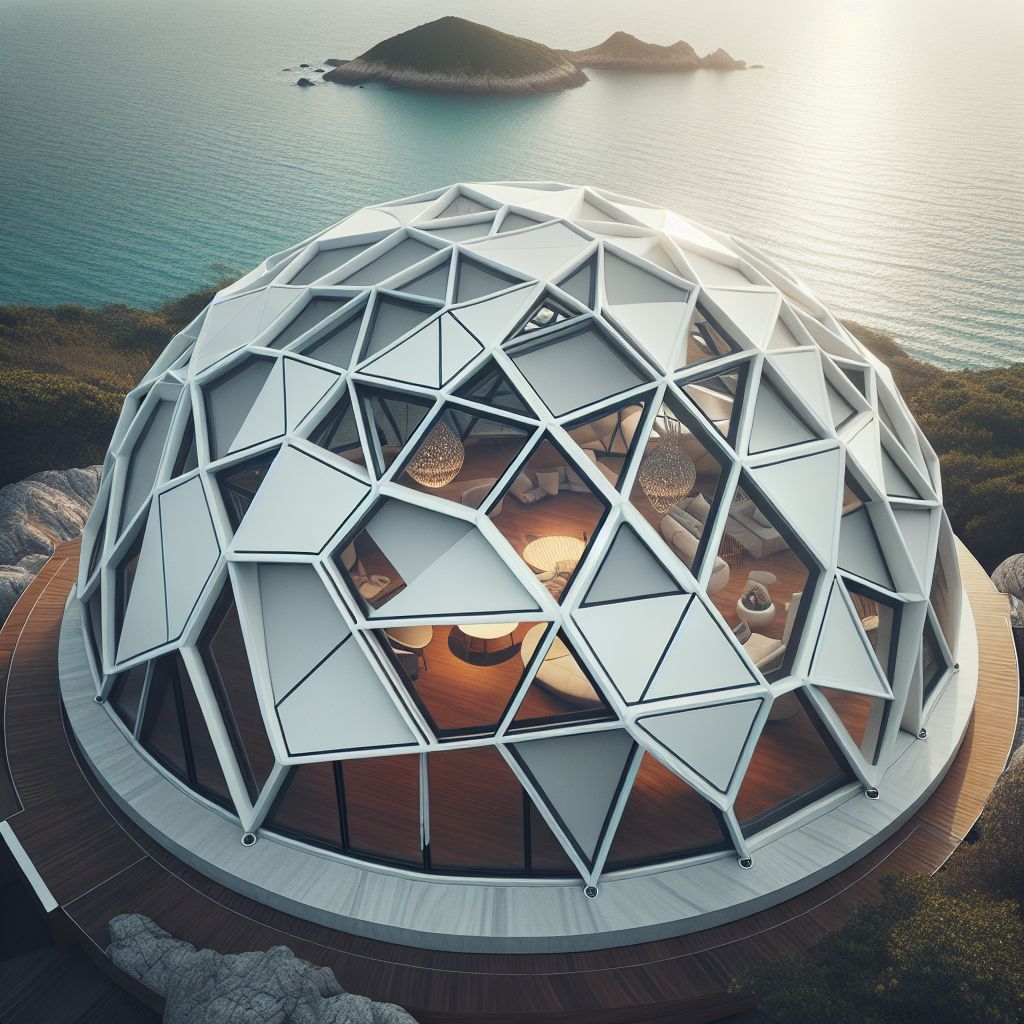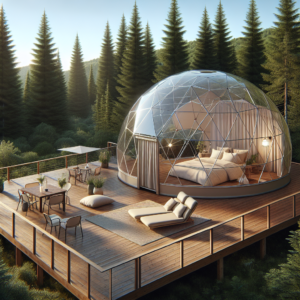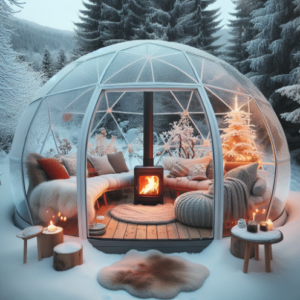
Key Takeaways
Geodomes are innovative, energy-efficient homes ideal for coastal and island environments.
Their unique structure offers superior resistance to extreme weather, making them a safe choice in challenging climates.
Sustainable materials and design principles are at the heart of geodome construction, aligning with eco-friendly living.
Natural ventilation and temperature control are inherent benefits of geodome designs, enhancing living comfort.
Implementing a geodome design requires consideration of location, materials, and the environment to ensure sustainability.
What is a Geodome and Why it’s a Game Changer for Coastal Living
Imagine a home that curves like the horizon, where the walls rise and fall like the waves of the sea. This is the essence of a geodome – a dome-shaped structure pieced together with triangles, forming a sphere-like habitat that is not just visually stunning but also incredibly resilient. Geodomes are a game-changer for coastal living because their unique design can withstand the high winds and corrosive salt air that often wear down traditional homes. They also offer a sustainable living solution that harmonizes with the delicate coastal ecosystems.
Breaking the Mold: The Geometric Efficiency of Dome Architecture
The geodome’s design is no accident. It’s a deliberate choice that reaps the benefits of geometric efficiency. The dome shape distributes stress evenly throughout the structure, making it extraordinarily strong. This means that geodomes can resist the punishing forces of nature that often batter coastal areas, like hurricanes and storms.
Moreover, the shape of a geodome eliminates the need for load-bearing walls, maximizing interior space. This not only creates an open, airy feel inside but also allows for flexibility in design. You can tailor the interior to your needs without worrying about structural limitations.
The Eco-Friendly Aspects of Geodomes
Energy Efficiency: The spherical design minimizes surface area, reducing heat loss and gain, which translates to lower energy consumption.
Material Efficiency: Geodomes require fewer building materials per square foot compared to traditional structures, reducing environmental impact.
Renewable Energy Integration: The shape is ideal for installing solar panels and other renewable energy systems, promoting self-sufficiency.
The environmental benefits of geodomes are clear. Their energy efficiency is unparalleled because the shape allows for even temperature distribution, cutting down on heating and cooling costs. The reduced surface area of a dome means less exposure to the elements, and less energy is required to maintain a comfortable interior climate.
When it comes to materials, less is more. The construction of a geodome is material-efficient, which means you use fewer resources to build a stronger structure. This efficiency translates to a smaller carbon footprint and a happier planet.
And let’s not forget the potential for renewable energy integration. The dome’s curved surface is a natural fit for solar panels, capturing sunlight from various angles throughout the day. This makes geodomes an excellent choice for those looking to live off-grid or reduce their reliance on traditional energy sources.
Harmony with the Elements: Adaptive Geodome Features
Weathering the Storm: Geodomes and Climate Resilience
Coastal and island environments are known for their beauty, but they also come with a set of challenges, primarily the weather. Geodomes rise to this challenge with their innate strength. Their aerodynamic shape allows winds to flow over the structure, greatly reducing the pressure that can cause damage during a storm.
But it’s not just about withstanding the wind. Geodomes are also designed to be water-tight and corrosion-resistant, which is essential in areas with high humidity and saltwater exposure. Their durability in the face of these elements makes them an ideal choice for coastal living.
Staying Cool: Natural Ventilation and Temperature Control in Geodomes
One of the most remarkable features of geodomes is their ability to regulate temperature naturally. The design promotes air circulation, creating a convection effect that keeps the interior comfortable without relying heavily on artificial cooling systems. This not only saves energy but also ensures a fresh and healthy living environment.
Seamlessly Merging with Nature: Environmental Integration Techniques
Geodomes are more than just a place to live; they’re a way to become one with your surroundings. The dome’s shape and construction materials can be chosen to blend into the landscape, minimizing visual impact and preserving the natural beauty of coastal and island settings.
Use local, natural materials to reduce transportation emissions and support the local economy.
Design your geodome to complement the existing topography, reducing the need for extensive land modification.
Incorporate living roofs or green walls to further integrate with the environment and provide additional insulation.
By choosing materials that are indigenous to the area, you not only reduce your carbon footprint but also ensure that your home is equipped to handle the local climate. And by working with the land, rather than against it, you maintain the integrity of the ecosystem, which is crucial for long-term sustainability.
Laying the Foundation: Constructing Your Geodome
Before the dream of living in a geodome can become a reality, you need to lay the groundwork—quite literally. Choosing the right location is crucial, especially in coastal and island environments where the land can be as unpredictable as the weather. Look for a site that’s elevated and stable, reducing the risk of flooding and ensuring your geodome stands on solid ground.
From the Ground Up: Starting Your Geodome Project
When you’re ready to start your geodome project, the first step is to get to know your land. Conduct a thorough site analysis to understand the soil composition, wind patterns, and sun path. This information will guide you in positioning your geodome for optimal stability and energy efficiency. Remember, building in harmony with nature is key to sustainable living.
Materials Matter: Choosing Eco-conscious Building Components
The materials you choose for your geodome are just as important as the design itself. Opt for sustainable, locally-sourced materials that minimize environmental impact. Consider using bamboo, recycled steel, or sustainably harvested wood. These materials are not only eco-friendly but also stand up well to the harsh coastal conditions.
The Heart of the Home: Geodome Interior Innovations
The heart of your geodome home is its interior—where design meets function. The intrinsic beauty of a geodome’s interior lies in its openness and the feeling of connectedness it offers. You’ll find that without the need for interior load-bearing walls, the possibilities for creative design are nearly endless.
Maximizing Space: Functional and Flexible Interiors
Inside a geodome, every square inch counts. Use multi-functional furniture and built-in storage to make the most of the space. Design with flexibility in mind; movable partitions can transform a single large room into cozy, private areas as needed. This adaptability is perfect for adapting to the changing needs of your household.
Sunlight and Shadows: Making the Most of Natural Lighting
The dome’s structure allows for creative placement of windows and skylights, flooding your home with natural light and reducing the need for artificial lighting during the day. This not only cuts down on energy consumption but also connects you with the natural rhythm of day and night, which is essential for well-being.
Strategically place windows to capture the best views and promote cross-ventilation.
Install skylights to bring in sunlight from above, reducing reliance on artificial lighting.
Choose window treatments that allow you to control the amount of light and heat entering your home.
With thoughtful design, you can create a living space that’s not just efficient, but also emotionally uplifting. The dance of sunlight and shadows across the dome’s interior can be a daily source of inspiration and joy.
From Blueprint to Reality: Implementing Geodome Designs
Turning the blueprint of your geodome into a tangible structure is an exciting journey. It’s a process that calls for precision, patience, and a deep respect for the environment. Work with builders who are experienced in constructing geodomes and who share your commitment to sustainability.
Sustainability in Practice: Real-World Geodome Success Stories
Across the globe, geodomes are proving their worth as sustainable living solutions. From the windswept coasts of Chile to the serene islands of Southeast Asia, these structures are providing safe, eco-friendly homes that blend seamlessly with their surroundings. These success stories are a testament to the geodome’s potential to revolutionize how we think about living spaces.
Getting Started on Your Geodome Journey
Embarking on your geodome journey begins with a vision and a plan. Start by researching and connecting with the geodome community. Gather ideas, learn from others’ experiences, and create a clear roadmap for your project. With each step, you’ll be closer to making your sustainable living dream a reality.
Living the Geodome Dream: Daily Life and Maintenance
Living in a geodome is not just about enjoying its unique architecture; it’s about adopting a lifestyle that’s deeply connected with the environment. It’s about recognizing that every choice you make—from the food you eat to the way you conserve water—has an impact. And the good news is, the geodome’s design inherently supports a sustainable way of life, making these choices easier and more natural.
A Day in the Dome: Insights from Geodome Dwellers
Life under the dome can be magical. Waking up to the gentle diffusion of morning light through the skylights, spending afternoons in a living space that feels open yet intimate, and evenings observing the stars from the comfort of your home are daily realities for geodome dwellers. Residents often speak of a greater sense of connection to the natural world, a byproduct of the geodome’s design that encourages living in harmony with the environment.
Energy conservation is a daily practice, made simple by the dome’s efficiency. The natural flow of air means less reliance on air conditioning, and the strategic placement of windows and skylights reduces the need for electric lighting. And when it comes to utilities, many geodome homes are set up to use renewable energy sources, further reducing their environmental footprint.
But it’s not all about the structure itself. The community of geodome enthusiasts often share tips and tricks for sustainable living, whether it’s water-saving gardening techniques or the best way to compost household waste. This collective knowledge is a valuable resource for anyone looking to reduce their impact on the planet.
Embrace the natural lighting to reduce electricity usage.
Use renewable energy sources like solar panels.
Grow your own food in a garden or greenhouse dome attachment.
Compost organic waste to enrich your garden soil.
Collect and use rainwater for irrigation and non-potable uses.
Keeping Your Geodome Green: Tips for Sustainable Upkeep
Maintaining a geodome is about being mindful of your impact and making choices that align with eco-friendly principles. Regular maintenance checks are essential, especially after extreme weather events. Look for any signs of wear or damage and address them promptly to prevent bigger issues.
Use environmentally friendly products for cleaning and repairs, and consider the lifecycle of any item you bring into your home. The goal is to create a closed-loop system where waste is minimized, and resources are reused and recycled as much as possible.
Frequently Asked Questions (FAQ)
Can Geodomes Withstand Extreme Weather Conditions?
Yes, geodomes are exceptionally resilient in extreme weather conditions. Their rounded shape allows them to resist high winds, and the triangular elements of the structure distribute stress evenly, providing stability during earthquakes. Additionally, the materials used in geodomes can be selected for their durability and resistance to the corrosive effects of saltwater and humidity, making them ideal for coastal and island environments.
How Energy Efficient are Geodome Homes Compared to Traditional Houses?
Geodome homes are significantly more energy-efficient than traditional houses. The spherical design minimizes surface area, which reduces heat loss in winter and heat gain in summer. This, combined with the natural ventilation that occurs within a dome, means that geodomes require less energy for heating and cooling. Many geodome owners report lower utility bills and a smaller carbon footprint as a result.
What are the Best Materials for Building a Sustainable Geodome?
The best materials for building a sustainable geodome are those that are locally sourced, renewable, or recycled. Bamboo, recycled steel, and sustainably harvested timber are popular choices. These materials are not only environmentally friendly but also durable and well-suited to the demands of coastal and island climates. Additionally, using materials like low-VOC sealants and paints can improve indoor air quality and further reduce environmental impact.
Is it Possible to Live Off-Grid in a Geodome?
Absolutely. Geodomes are well-suited for off-grid living due to their energy efficiency and the ease with which they can integrate renewable energy systems. With the addition of solar panels, a wind turbine, a rainwater collection system, and a composting toilet, a geodome can be a self-sufficient living space that provides a high level of independence from traditional utility systems.
What are the Challenges of Building a Geodome on Coastal or Island Locations?
Building a geodome in coastal or island locations presents several challenges, such as securing a stable foundation on sandy or rocky soil, ensuring resistance to saltwater corrosion, and designing for potential flooding or storm surge events. It’s important to conduct a thorough site analysis, choose appropriate materials, and design with the specific environmental conditions in mind. Despite these challenges, the benefits of living in a geodome in such settings often outweigh the difficulties encountered during the construction process.





Leave a Reply